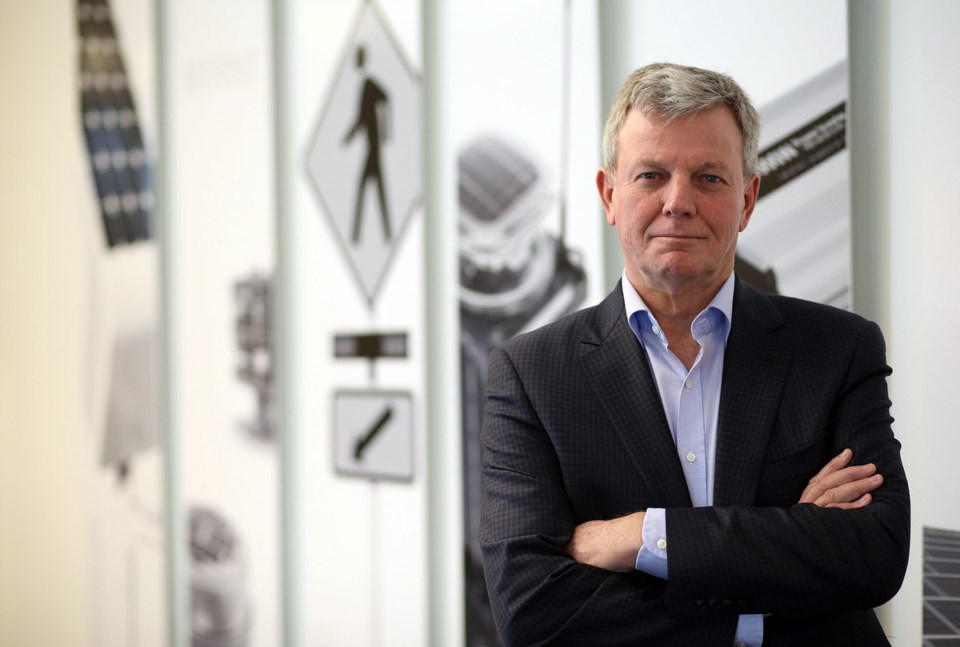When Carmanah Technologies reports its year-end financial results at the end of this month, the solar-lighting company will paint a picture of strength, stability and promise.
The Victoria-based company will report year-end revenue of more than $68 million US, a 56 per cent increase over 2014. Its forecast for earnings before interest, taxes, depreciation and amortization will exceed analysts’ predictions of $8.2 million US.
It’s impressive, considering the recent history of the 20-year-old firm.
“I’ve been a student of and a participant in turnarounds for the last 20 to 25 years and I’ve never seen anything turn around this rapidly,” said Carmanah chief executive John Simmons. “I can’t help but think the best is yet to come.”
Simmons’ optimism is a product of the work he and his team have put in over the past two and a half years to change the culture, outlook and profitability of a company that appeared headed for a cliff in 2013.
The company, founded in 1996 by David Green, was never really profitable, Simmons said. While it had grown over the years through acquisition, the net result was that by 2013 it had carried forward a $25-million tax loss.
The company, which now contracts out the manufacture of its products, had become globally known for its solar lighting gear, including LED and solar technology used in signal systems for marine aids to navigation, airfield ground lighting, offshore wind marking, aviation obstruction and traffic markets.
“The reality is [Carmanah] never actually made any money,” said Simmons. “And in the five years that preceded a shareholder-driven change in 2013, revenues fell from $60 million Cdn to $25 million US (reflecting a change in reporting).
“The company also lost $5 million on average each year and was clearly running out of runway.”
That point was driven home by board chairman Michael Sonnenfeldt in a letter to shareholders in the 2013 annual report. “Years of failed initiatives and operating losses had not only diminished financial capability, but had also sapped the confidence of our staff and our customers,” Sonnenfeldt wrote. “Cash was running out rapidly and the way forward was unclear.”
That prompted shareholders to act. They withheld votes for two incumbent board members at the annual general meeting in April 2013, which led to the resignation of chairman Robert Cruickshank and director Daniel Nocente, and eventually the resignation of chief executive Bruce Cousins.
As the company’s largest shareholder, Sonnenfeldt stepped in as chairman while Simmons, another shareholder, joined initially as a director and eventually CEO.
“The company didn’t have a lot of time, we needed to get to work,” said Simmons of his appointment.
He said it was poor execution more than anything that landed the company in its predicament. “The long and short of it is it didn’t work and, toward the end of 2012, the company was running out of money, the stock price was almost nothing and things were pretty bleak.”
At the time, Sonnenfeldt said it was a series of events that fundamentally changed Carmanah.
The new board established a new direction and focus.
Simmons said when he stepped in they focused on improving performance. “We created a whole bunch of changes in structure, embraced an open and forthright culture and created alignment around profitability.” The company tied compensation to profitability, added a broad stock-option plan for workers and gave employees more responsibility — having them control their costs and expenses and being compensated accordingly.
“We treated them like adults, told them what we were trying to do and we didn’t permit people who weren’t engaged to be there,” said Simmons. “When you have engaged people who are smart and tell them what we are trying to do, alignment comes very easily.”
The change in alignment meant major personnel changes.
Carmanah, which at one point employed more than 260, had about 68 employees in 2013. Simmons said in the first year that number dipped slightly to 66, but they had also hired 40 new people.
The company also brought back some key personnel who had left when Carmanah started to slide.
“We were successful in getting some of them back,” said Simmons. “They understood the DNA of this place and helped us in rebuilding.”
Carmanah set its sights on its future, once again being a leader in signal lighting and marine aids for navigation.
Simmons said they have already grown via acquisition and there is more opportunity ahead.
“The market is fragmented with lots of small competitors around the world,” he said. “We think we can start to acquire those and bring them into our company over time.”
Last year Carmanah completed the acquisition of the Sabik Group from Finland, which added to its bottom line in 2015.
“We went from $25 million US in revenue in the first year [2013] to $43 million US and turned a $5 million EDITDA loss to $3.4 million in profitability [in 2014],” said Simmons. “And in 2015, revenue will be $68 million US. It’s an amazing trajectory.”
Over that same period, Carmanah’s stock price has gone from hovering around a quarter per share in 2013 to closing at $5.13 on Monday.
Analysts who have covered the stock now rate Carmanah as either a buy or strong buy.
Simmons said for those on the inside, the turnaround has not come as a surprise. “There’s not a lot of magic in this, but we work hard and people are engaged and enjoying what they are doing,” he said. “When you have [that], good things happen. I’m a huge believer in the people and their capability to come together and go beyond.”
The next steps are to continue looking for acquisitions, increase points of sale around the world and spend on innovation.
- - -
Clarification: The reference to the increase in Carmanah Technologies’ share price did not take into account a stock consolidation in August 2014 that lifted the company’s stock from 26 cents a share to $2.60.



